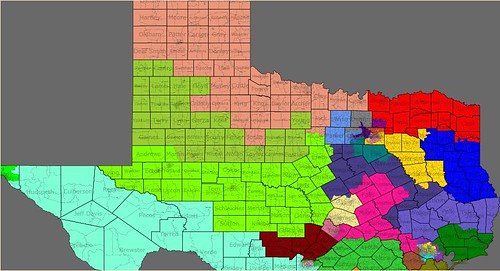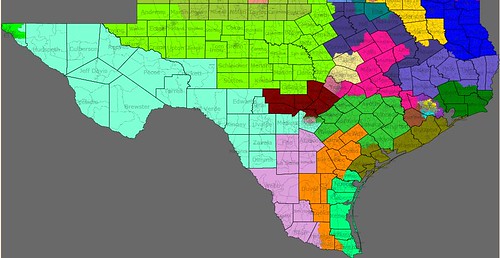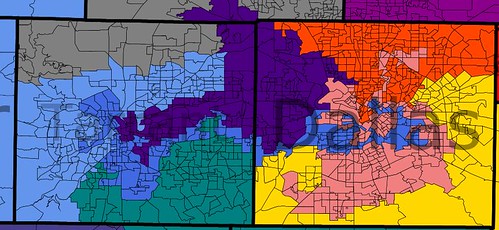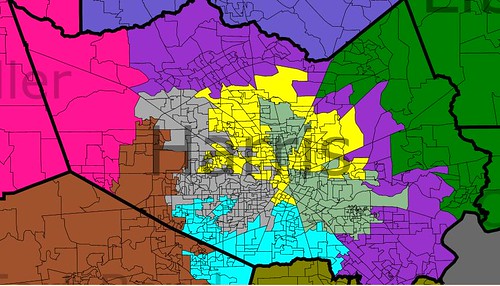Crossposted at Daily Kos
It’s been a while since I wrote one of these, and foolishly, I penned this diary yesterday evening with little sense that something as dramatic as a Supreme Court retirement was mere hours on the horizon…alas!
Irrespective of the indisputably riveting SCOTUS chatter, let’s start with the gov contests of 2009 before moving to 2010. Read about all 36 races below the fold…
First, a map of the entire gubernatorial state of play between 2009 and 2010:

As you may have guessed, light-colored states are open seats (10 Democratic, 7 Republican). The states with circular holes (Minnesota, Florida, and Wyoming) are states where it isn’t clear yet whether or not the incumbent will seek another term.
2009
New Jersey – Jon Corzine (D) seeking 2nd term
Outlook: Tossup
Polls still show Corzine losing to GOP frontrunner Chris Christie, a former U.S. Attorney; the latest poll, from Monmouth University, shows Christie leading 39-35, with Corzine’s job approval at 40% to 49% disapproval. While New Jersey politicians typically poll badly, it’s foolish to discount these numbers…Corzine is in serious trouble. If there is a silver lining, it is that as public confidence in the economy and the direction of the country has ticked up, Corzine’s numbers have inched closer to parity with Christie. I’ve heard the occasional rumor that the Governor will “pull a Torricelli” and bow out at the 11th hour in favor of someone less controversial. Three problems with that: the replacement candidate won’t have Corzine’s money, Garden State voters may (rightfully) grow tired of those sorts of antics, and who would the replacement be, anyway? (I don’t think popular former Gov. Dick Codey fancies a comeback.) For better or worse, Corzine may have to correct this ship himself.
Virginia (OPEN) – Tim Kaine (D) term-limited
Outlook: Tossup
As in 2005, a well-liked Democratic Governor is term-limited, the Republicans have united around the Attorney General as their nominee, and said Attorney General has a lead in most polls on the Democratic possibilities. Hopefully, as in 2005, dynamics will change after the June 9 Democratic primary. On the Dem side, Terry McAuliffe has seemingly catapulted into the lead, if the latest SurveyUSA poll is to be believed, with 38% to 22% each for State Del. Brian Moran and State Sen. Creigh Deeds. Each of the candidates narrowly loses to Attorney General Bob McDonnell, for now, but as I said, Kaine was well behind Jerry Kilgore all through summer 2005 as well. One odd item of trivia: the sitting President’s party has lost every Virginia gubernatorial election since Watergate. Such history is always subject to change (“bellwether Missouri” says hi), but it’s an amusing stat nonetheless.
And on the docket for 2010
Alabama (OPEN) – Bob Riley (R) term-limited
Outlook: Leans Republican
To date, the sole official GOP candidate is real estate developer Tim James, son of 1994-1998 GOP Gov. Fob James, though a run seems quite likely by the legendary (and not in a good way) Roy Moore, former Chief Justice of the state’s Supreme Court. The major Democratic candidates, Rep. Artur Davis and State Agriculture Commissioner Ron Sparks, seem a heck of a lot more impressive, but given the Yellowhammer State’s continued leanings (even a boost in black participation only pushed Obama to 39% here), the Republicans must warrant an early if narrow edge.
Alaska – Sarah Palin (R) seeking 2nd term
Outlook: Safe Republican
Congratulations to one Bob Poe and one Rob Rosenfeld, two Democrats who I assume are as unfamiliar to most Alaska voters as they are to the average political junkie, for choosing to run against Gov. Thanks But No Thanks. The drama surrounding Palin’s career — and there is plenty — is unfortunately unrelated to her prospects for reelection at the moment.
Arizona – Jan Brewer (R) seeking full term
Outlook: Tossup / Tilts Republican
According to Politics1, Brewer is already drawing several primary opponents even as not a single Democrat has yet announced. Insert all clichés here about the advantages of incumbency, but Arizonans I talk to seem dubious about Brewer’s ability to effectively confront the state’s fiscal problems. Dems hold their breath as Attorney General Terry Goddard mulls it over, and Phoenix Mayor Phil Gordon’s name has been tossed around more than once as well.
Arkansas – Mike Beebe (D) seeking 2nd term
Outlook: Safe Democratic
Beebe is one of the few governors presumably not suffering from declining approval ratings these days, and last I checked was one of the most popular in the nation.
California (OPEN) – Arnold Schwarzenegger (R) term-limited
Outlook: Leans Democratic pickup
At the moment, the Republican primary is, surprisingly, more crowded than the Democratic one, with former Rep. Tom Campbell, State Insurance Commissioner Steve Poizner, and former eBay CEO Meg Whitman duking it out. Most seem to give the well-financed Whitman an edge, though Poizner is the only candidate of the three to have successfully sought statewide office. On the Dem side, two Bay Area heavyweights are in (Attorney General and former Gov. Jerry Brown and San Francisco Mayor Gavin Newsom) while Lt. Gov. John Garamendi is out (underwhelmed by his poll numbers against Brown and Newsom, he is seeking to replace Ellen Tauscher in Congress if and when she is confirmed as one of Hillary Clinton’s deputies). The mega-name still weighing his options? Los Angeles Mayor Antonio Villaraigosa, the only Southern Californian and the only Hispanic being talked about in a state ever more ethnically diverse and heavily dominated by its southern counties. This race was assured long before it began to be a headliner.
Colorado – Bill Ritter (D) seeking 2nd term
Outlook: Leans Democratic
Most thought Ritter was one of the less obviously endangered governors in 2010 (and nearly all of them have taken a hit from economic worries and state budget crises), but a Public Policy poll shows trouble, with his approval in the red at 41-49 and mediocre numbers against potential opponents like former Rep. Scott McInnis and State Senate Minority Leader Josh Penry. There is plenty of time for Ritter to turn things around, but his supporters should certainly fight complacency.
Connecticut – Jodi Rell (R) seeking 2nd full term
Outlook: Likely Republican
There are credible Democratic candidates in former State House Speaker Jim Amann, Secy. of State Susan Bysiewicz, and Stamford Mayor Dan Malloy, but as far as I know Rell is still fabulously popular (as the New York Times puts it, her approval ratings read like the temperature in Honolulu) and should defeat all comers.
Florida – Charlie Crist (R) either seeking 2nd term or running for the Senate
Outlook: Likely Republican if Crist runs again, Tossup if he vacates
The new conventional wisdom seems to be that Crist is prepping to run for the Senate and will announce in a matter of days, not weeks. To sum up what would happen in that event, I’ll sum things up in four words: “open governor’s mansion, Florida”. Let the generous cash infusions from both national parties begin.
Georgia (OPEN) – Sonny Perdue (R) term-limited
Outlook: Leans Republican
This race saw an interesting shakeup recently when Lt. Gov. Casey Cagle, the putative frontrunner in the Republican primary and possibly in the general election as well, bowed out suddenly based on recent health concerns (there were other rumors about what informed his decision, but we’ll not go into those). The Republican primary is absurdly crowded, even if you only note the major candidates: Secy. of State Karen Handel, Insurance Commissioner John Oxendine, State Sen. Eric Johnson, Rep. Nathan Deal, and State Rep. Austin Scott. On the Democratic side, Atty. Gen. Thurbert Baker easily leads State House Minority Leader DuBose Porter and former Labor Commissioner David Poythress, but all eyes are on former Gov. Roy Barnes, who may mount a comeback and would probably be favored over Baker. After Obama’s 47% total in Georgia, Democrats are curious to test the waters either with a previous known quantity like Barnes or a well-known black candidate like Baker.
Hawaii (OPEN) – Linda Lingle (R) term-limited
Outlook: Leans Democratic pickup
The Republicans are lucky to have a well-known candidate like Lt. Gov. Duke Aiona, because any competent Democrat starts out favored in an open governor’s race in deep blue Hawaii (as an aside, remember circa 2004 when everyone fretted about future trends in the Aloha State?). The only Dem candidate so far is longtime Rep. Neil Abercrombie, but Honolulu Mayor Mufi Hannemann and State Sen. Colleen Hanabusa, two names perennially floated for statewide office, are each considering an entrance.
Idaho – Butch Otter (R) seeking 2nd term
Outlook: Safe Republican
Well, who do you have in mind?
Illinois – Pat Quinn (D) seeking full term
Outlook: Likely Democratic
Here is some food for thought from Public Policy Polling: Quinn’s approval rating is a healthy 56%, quite good for a governor in 2009’s political climate, yet Atty. Gen. Lisa Madigan, a possible primary foe, leads the incumbent 45-29. Could it simply be that Madigan is more popular than Quinn? Rumor has long favored a Madigan gubernatorial run with State Treasurer Alexi Giannoulias seeking the Senate seat, but the entire Blagojevich saga, and resulting ascent of the purportedly squeaky clean Quinn, may have cooled Madigan’s interest a bit. The GOP field includes at least two fairly big names in DuPage County State’s Attorney Joe Birkett and State Sen. Bill Brady, but either Quinn or Madigan would seem odds-on favorites for now.
Iowa – Chet Culver (D) seeking 2nd term
Outlook: Leans Democratic
Like Ritter in Colorado, Culver is appearing more vulnerable than was initially suspected, but the GOP bench is weak and plenty of Democratic governors seem more obvious targets. I hear that far-right icon Rep. Steve King is mulling a run, but that hardly seems reason for Culver to tremble given Iowa’s decidedly moderate electorate.
Kansas (OPEN) – Mark Parkinson (D) retiring after partial term
Outlook: Likely Republican pickup
It’s too bad the newly minted Governor isn’t interested in a full term, because he might actually have a fighting chance (though perhaps not against longtime Sen. Sam Brownback, probably the next Governor regardless of whom the Democrats eventually settle on).
Maine (OPEN) – John Baldacci (D) term-limited
Outlook: Leans Democratic (one assumes)
The only announced candidate right now with an electoral history is former Atty. Gen. Steve Rowe (D), after former Rep. Tom Allen declined. I’ve heard rumors about Rep. Mike Michaud, but it seems that few are yet anxious to capitalize on this once-every-eight-years opportunity.
Maryland – Martin O’Malley (D) seeking 2nd term
Outlook: Likely Democratic
O’Malley’s approvals are iffy but the GOP bench is virtually nonexistent, other than former Gov. Bob Ehrlich, who already lost to O’Malley in 2006.
Massachusetts – Deval Patrick (D) seeking 2nd term
Outlook: Likely Democratic
Patrick’s approval ratings are actually rather horrendous (27-68 according to SurveyUSA). The only announced challenger is an Independent, businessman Christy Mihos, and if Patrick has anything to feel good about, it’s the lack of quality GOP possibilities in the Bay State (odd considering their 16-year reign over the governor’s mansion). There has been gossip about a serious primary challenge, and with 27% approval, one assumes there would be room for that, but nothing has materialized just yet. This is definitely one to watch, for internecine fights if nothing else.
Michigan (OPEN) – Jennifer Granholm (D) term-limited
Outlook: Tossup
With redistricting around the corner and Michigan’s economy far worse even than the national one, this is a major concern for the Democrats. It is said that Lt. Gov. John Cherry (D) fails to impress as a stump speaker, but for now he is the odds-on primary favorite over Macomb County Sheriff Mark Hackel, MSU Trustee George Perles, State Rep. Alma Wheeler Smith, and former Flint Mayor Don Williamson (who resigned to avoid recall in February). Non-fans of Cherry’s hope to see State House Speaker Andy Dillon jump in. Major Republican candidates include Rep. Pete Hoekstra (ranking member on House Intelligence), State Sen. Tom George, Secy. of State Terri Lynn Land, and Atty. Gen. Mike Cox. The polls between Cherry and the Republicans are even at best, trending the wrong way at worst.
Minnesota – Tim Pawlenty (R) not sure whether he’ll seek 3rd term
Outlook: Tilts (not Leans) Republican if Pawlenty runs, Leans Democratic otherwise
Pawlenty has made no indications that he won’t seek a third term, but isn’t exactly jumping on a reelection campaign either. The Democratic field is crowded, with five current or former state legislators, Ramsey County Attorney Susan Gaertner, and former Sen. Mark Dayton. Until we’re clear on Pawlenty’s plans, the situation remains opaque. (And honestly, aren’t we all accustomed by now to long waits re: Minnesota electoral politics?)
Nebraska – Dave Heineman (R) seeking 2nd full term
Outlook: Safe Republican
Politics1 lists no announced or potential candidates. That about sums this one up.
Nevada – Jim Gibbons (R) seeking 2nd term
Outlook: Likely Democratic pickup if Gibbons wins primary, Tossup otherwise
Last I heard Gibbons’ approval is in the 20s. The good news is that he’ll be gone after 2010; the bad news is that he may well lose the GOP primary to a superior pick like former State Sen. Joe Heck. No official Dem candidate yet, but the bench is deep considering Democrats’ dominance of statewide offices and the beginning of term limits affecting the state legislature.
New Hampshire – John Lynch (D) presumably seeking 4th term
Outlook: Safe Democratic
Lynch was reelected with 74% in 2006 and 70% in 2008, so he would have had to crash and burn since then (and I don’t think he has) to face a tough race in 2010.
New Mexico (OPEN) – Bill Richardson (D) term-limited
Outlook: Likely Democratic
Lt. Gov. Diane Denish is Richardson’s obvious successor and the Republican bench in the Land of Enchantment is as poor as ever. I suppose the dynamics could shift here, but for now, this is looking like a snooze-inducing changing of the guard.
New York – David Paterson (D) seeking full term
Outlook: Tossup if Paterson wins primary, Likely Democratic otherwise
Did I read right when I saw his approval rating at 19%? Atty. Gen. Andrew Cuomo says he isn’t interested in running, for now, but players in the New York Democratic Party must be praying that he’s lying. Fortunately, New York is bluer than ever, but Paterson is damaged goods and someone simply must take the leap.
Ohio – Ted Strickland (D) seeking 2nd term
Outlook: Leans / Likely Democratic
Strickland’s approval is a healthy 56%, though it’s 48% on the state’s inarguable top issue, the economy. Personally, I give him kudos for somehow maintaining decent numbers while serving as Governor of economically battered Ohio during a severe recession. His only announced opponent so far is State Sen. Kevin Coughlin.
Oklahoma (OPEN) – Brad Henry (D) term-limited
Outlook: Tilts Republican pickup
This is something of a doppelganger to Hawaii. Like Linda Lingle, Henry has preserved his favorability in a politically adverse state, the incumbent party’s candidate(s) is (are) strong, but the overwhelming partisan leanings of the state give the opposition party a leg up. Democrats Jari Askins, the Lt. Governor, and Drew Edmondson, the Atty. General, are no hacks, but this state was John McCain’s best at 66-34 over Obama. Rep. Mary Fallin leads the GOP field for now, but media favorite former Rep. J.C. Watts is seriously floating his name as well.
Oregon (OPEN) – Ted Kulongoski (D) term-limited
Outlook: Likely Democratic
If Oklahoma is a sort of reverse Hawaii in 2010, Oregon is Maine’s twin. As in Maine, the Democrats, whose bench is deep, should be enthused about a chance at the top office opening up in a blue state, particularly since the incumbent Governor’s approvals were never stellar, but only a single serious candidate has yet jumped in (in this case, former Secy. of State Bill Bradbury).
Pennsylvania (OPEN) – Ed Rendell (D) term-limited
Outlook: Tossup
Along with Michigan, this will be big-ticket defense for the Democrats, and for the same reasons. In this case, history would appear to be on the Republicans’ side — Rendell has been Governor since 2002, the GOP was in power from 1994-2002, the Dems from 1986-1994, the GOP from 1978-1986, the Dems from 1970-1978, the GOP from 1962-1970, the Dems from 1954-1962…see a pattern? But history is always true until it isn’t anymore. Businessman Tom Knox is the only announced Democratic candidate but the names being bandied about are some big ones, including Pittsburgh heavyweights Dan Onorato, the Allegheny County Executive, and Jack Wagner, the state’s Auditor General. On the GOP side, Rep. Jim Gerlach is looking at the race (though the NRSC wants him to challenge Arlen Specter), while Atty. Gen. Tom Corbett is the frontrunner for now.
Rhode Island (OPEN) – Don Carcieri (R) term-limited
Outlook: Who the heck knows?
No Democrat or Republican is running yet to replace Carcieri in liberal Rhode Island. But former Sen. Lincoln Chafee (probably) is, and as an Independent. Chafee did serve in the Senate as a Republican, but now that he is a third-partyer there is little love left for him in the GOP, particularly with the Steve Laffey wing ascendant. Meanwhile, Democrats have no candidate to win what should be a slam dunk pickup. This could be interesting…
South Carolina (OPEN) – Mark Sanford (R) term-limited
Outlook: Likely Republican
Compared to Alabama and Georgia, the Palmetto State Democratic bench is weak. The current odds-on favorite to replace Sanford is backbencher Rep. Gresham Barrett (R), and rumors abound of a run by Lt. Gov. Andre Bauer, who would give Barrett a competitive primary. For now, it’s hard to see Democrats running seriously here.
South Dakota (OPEN) – Mike Rounds (R) term-limited
Outlook: Safe Republican assuming Rep. Herseth Sandlin (D) doesn’t run
The gossip about Rep. Stephanie Herseth Sandlin (D) has visibly died down, so drama will likely be reserved for the Republican primary (currently headlined by Lt. Gov. Dennis Daugaard and State Senate Majority Leader Dave Knudson).
Tennessee (OPEN) – Phil Bredesen (D) term-limited
Outlook: Leans Republican pickup
State Senate Minority Leader Roy Herron, former State House Majority Leader Kim McMillan, and businessman Mike McWherter (son of former Gov. Ned McWherter), are credible choices on the Democratic side, but momentum has long been with the Republicans in Tennessee (along with Louisiana, West Virginia, Arkansas, and Oklahoma, it was one of five states to move against the Democrats and Obama in the 2008 presidential election compared to 2004). Between Shelby County D.A. Bill Gibbons, Knoxville Mayor Bill Haslam, State Senate Speaker Ron Ramsey, and Rep. Zach Wamp, the GOP should be well positioned to snatch this one (for redistricting purposes, Democrats should stay focused on races for the evenly divided state House).
Texas – Rick Perry (R) seeking 3rd full term
Outlook: Likely Republican
My gut tells me all statewide races in Texas should automatically be put as Safe Republican unless specific conditions indicate otherwise, but the lack of certainty about this race’s development forces me to stay open-minded. As we all know, Perry faces a stiff and long-anticipated (by long-anticipated, I mean that it’s been chatted about for eight years at least) primary challenge from Sen. Kay Bailey Hutchison. Hutchison was expected to trounce Perry, but the governor’s recent appeal to far-right secessionists and fundamentalists seems to have helped his viability against the famously popular Hutchison. And the Democrats? Former Ambassador to Japan Tom Schieffer and — yup — Kinky Friedman.
Vermont – Jim Douglas (R) seeking 5th term
Outlook: Tilts Republican
Douglas has routinely maintained good approvals and capitalized on a divided left due to Vermont’s electorally strong Progressive Party, but the Democrats seem ready to give him a real race in 2010, with Secy. of State Deb Markowitz and State Sen. Doug Racine (who lost to Douglas by a hair in 2002) both announced candidates. If the third parties sit this one out for once, there may be a real shot at turning Vermont’s state government wholly blue, especially with an energized left in the wake of gay marriage’s statewide enactment.
Wisconsin – Jim Doyle (D) seeking 3rd term
Outlook: Tossup / Tilts Democratic
Doyle’s fundraising hints at a third bid, and familiar Republicans like former Rep. Mark Neumann and Milwaukee County Executive Scott Walker are lining up to take him on. With Doyle’s approvals a measly 32-63, color me surprised that more commentators aren’t characterizing him as seriously vulnerable.
Wyoming (OPEN???) – Dave Freudenthal (D) term-limited?
Outlook: Safe Democratic if Freudenthal runs, Likely Republican pickup otherwise
Freudenthal is term-limited, but has been floating the idea of challenging the state’s term limit law in court, particularly since similarly worded state legislative term limits were overturned as unconstitutional a few years ago. Everyone seems to agree that Freudenthal is nearly unbeatable as an incumbent, but that few Democrats stands a chance in his absence.
OVERALL OUTLOOK: Gubernatorial races are looking to be the most fluid of elections in 2010, between term limits and a bevy of possible game-changing decisions by big names. With Democrats likely to stay firmly in the driver’s seat on Capitol Hill, Republicans would be wise to look for rebirth in governor’s mansions, as the gubernatorial map runs far less favorable to the Democrats in 2010, at least upon first glance. While the GOP will likely make a big sacrifice in California, and may be forced to defend Florida seriously should Crist seek the Senate seat, the Democrats will be playing major defense in New York, Michigan, and Pennsylvania, three key states for redistricting (Ohio is not yet in the bag either). Meanwhile, plenty of sitting governors sit on less than fantastic approval ratings, and many seem primed for an electoral scare. Of all offices being contested in 2010, governor’s mansions are, at this early date, on track to host the most volatile, crowded, and unpredictable election fights…and considering the implications (governors’ future high profiles, the role states as laboratories for national policy, and the more pedestrian question of redistricting), we should all be paying attention.



























